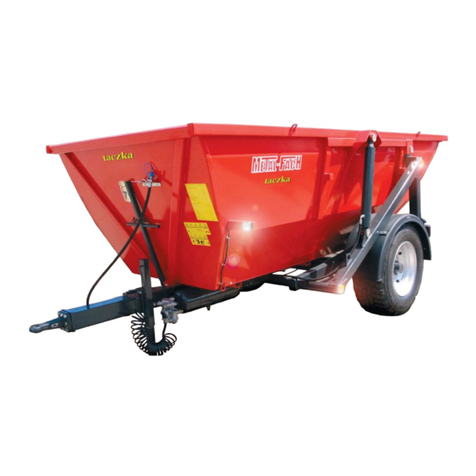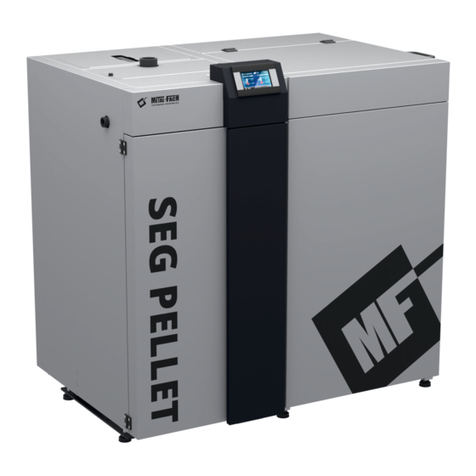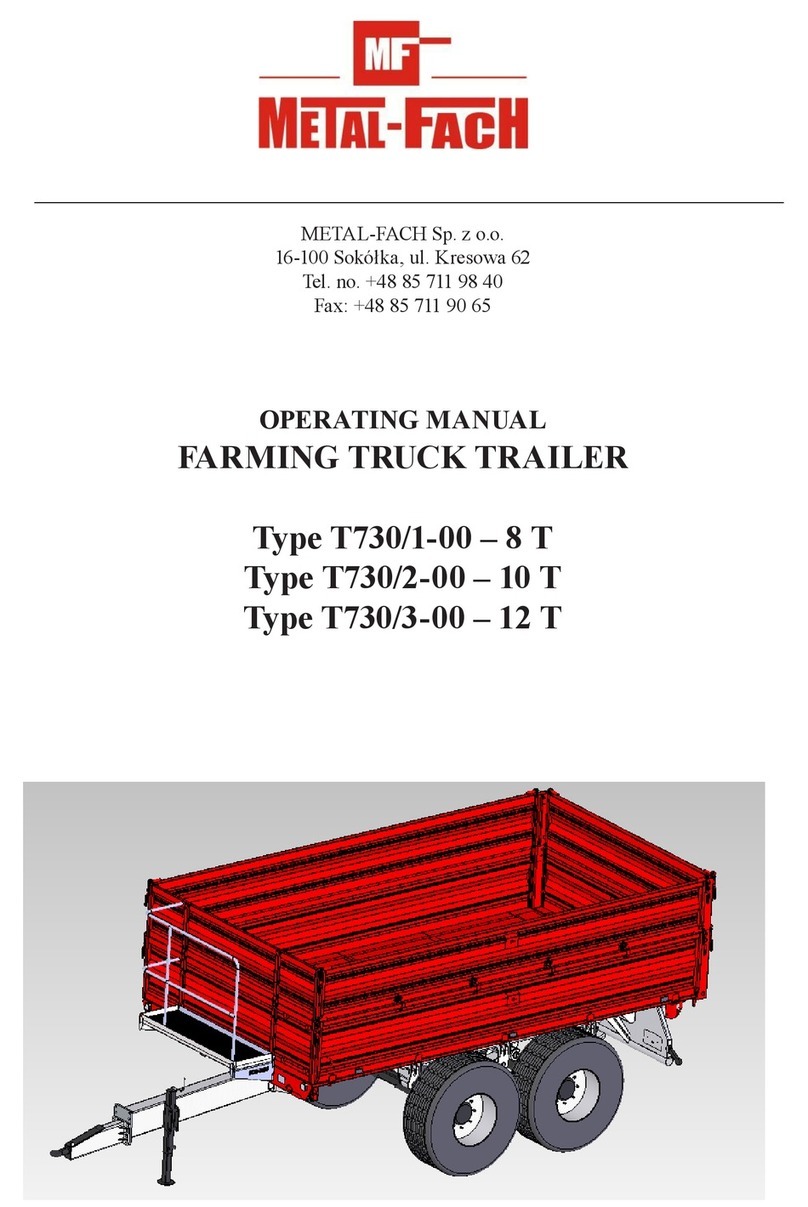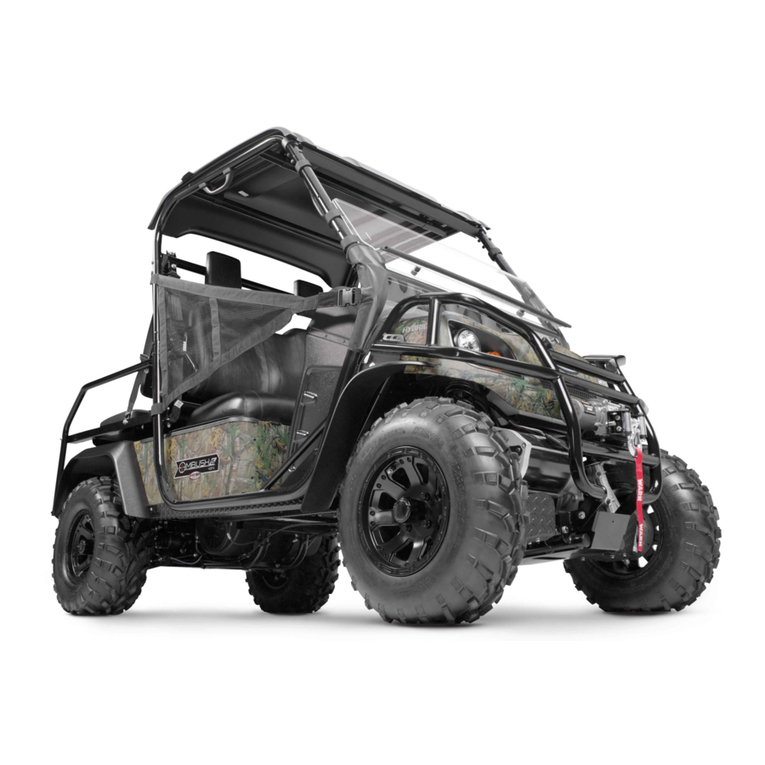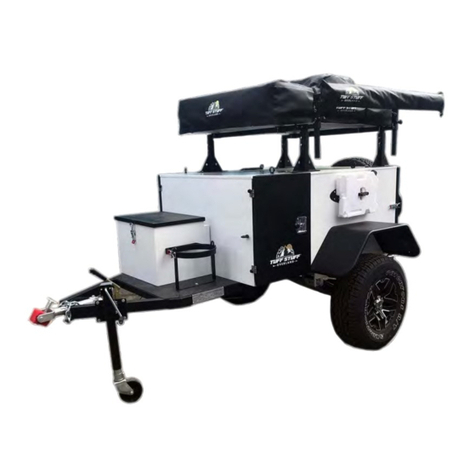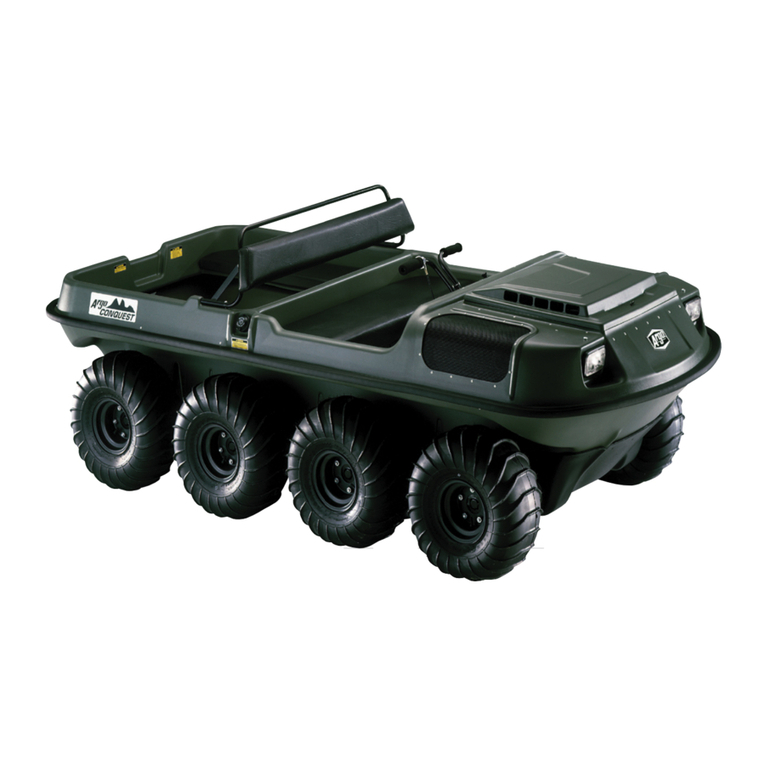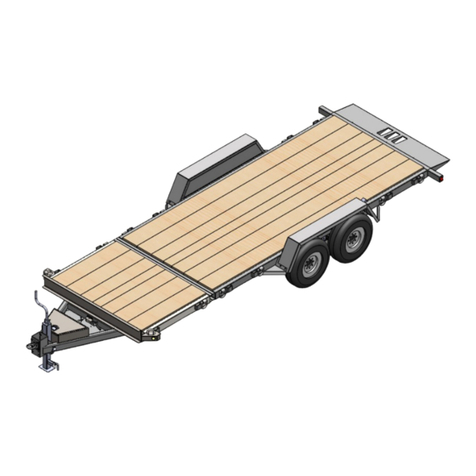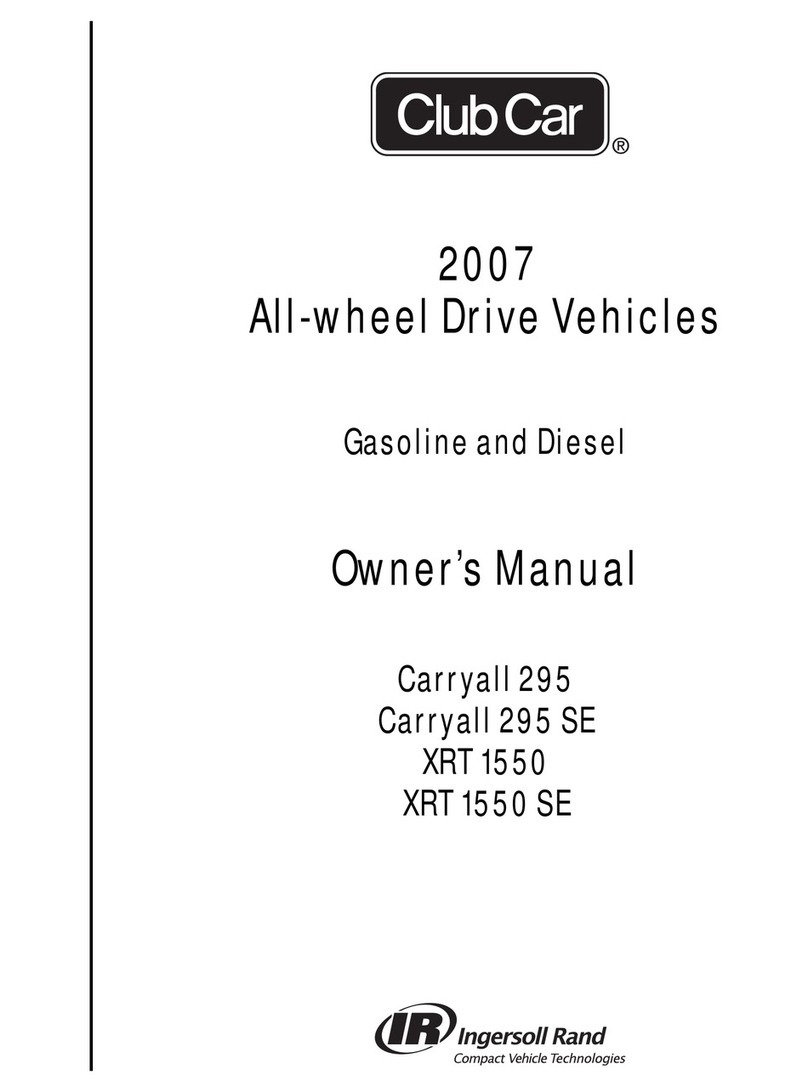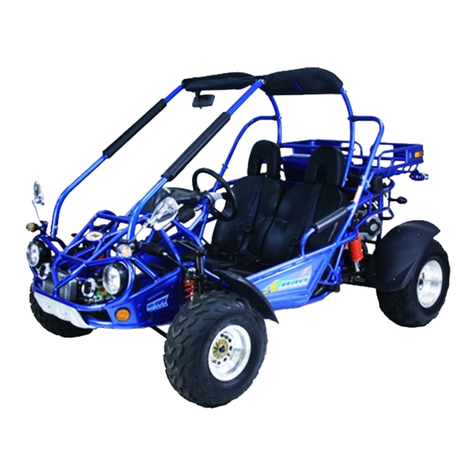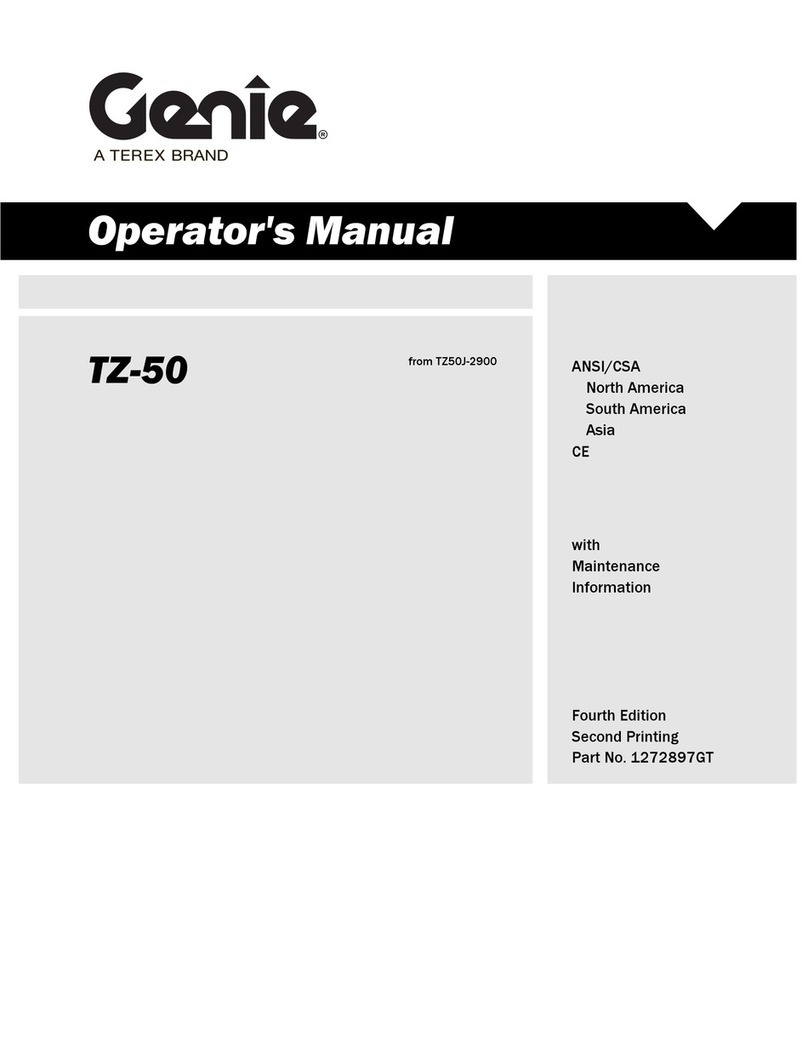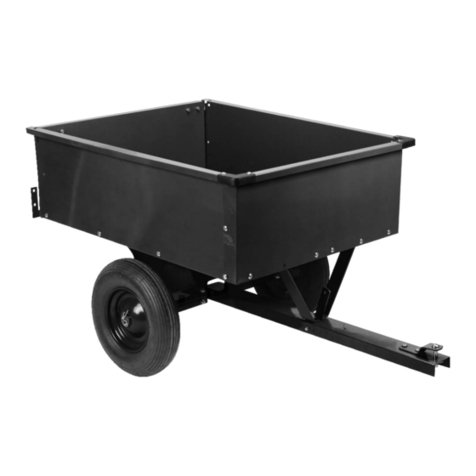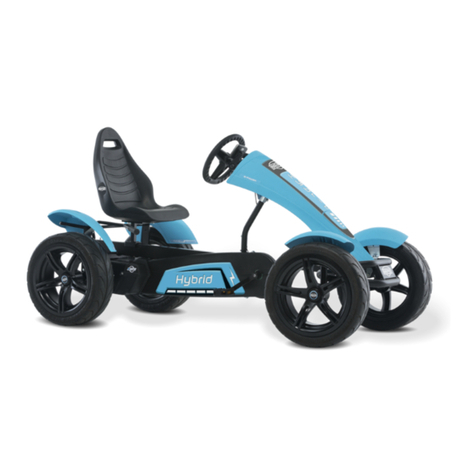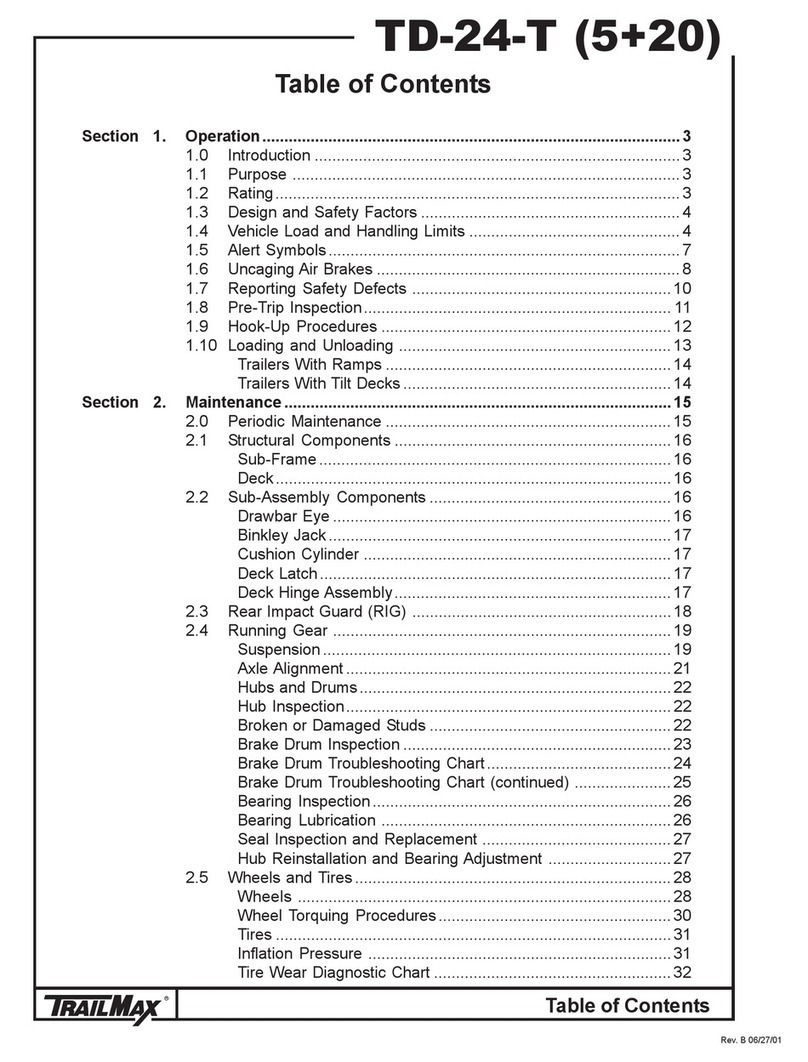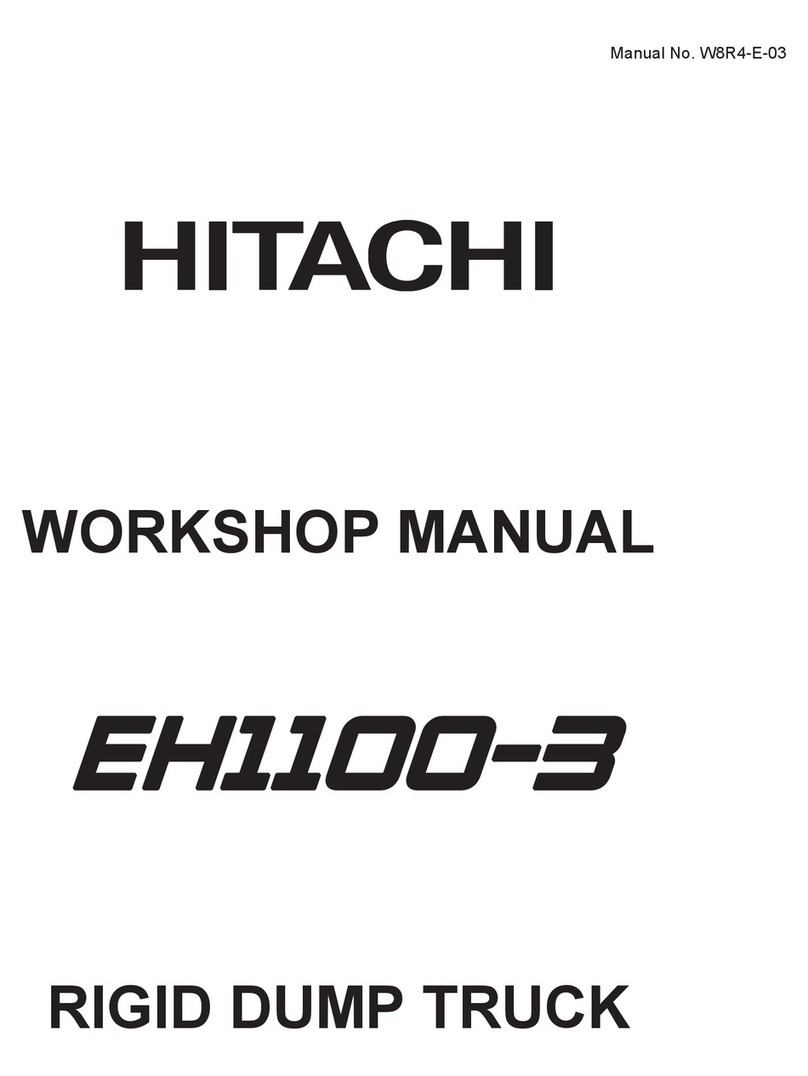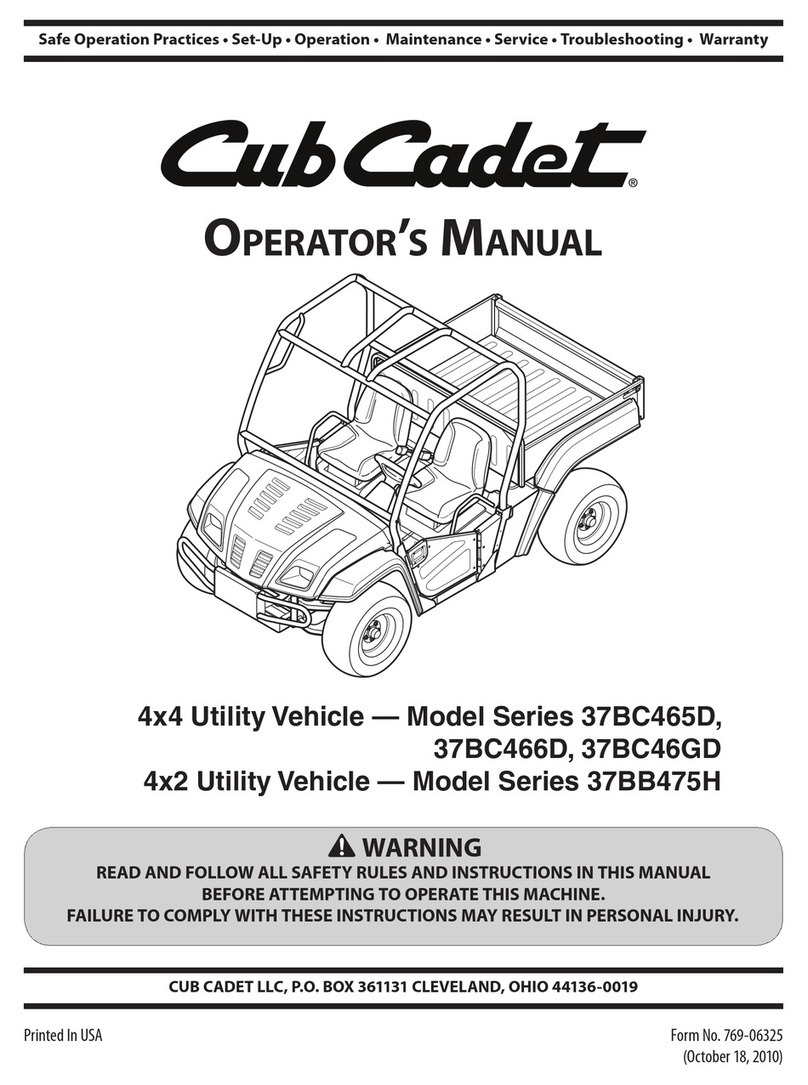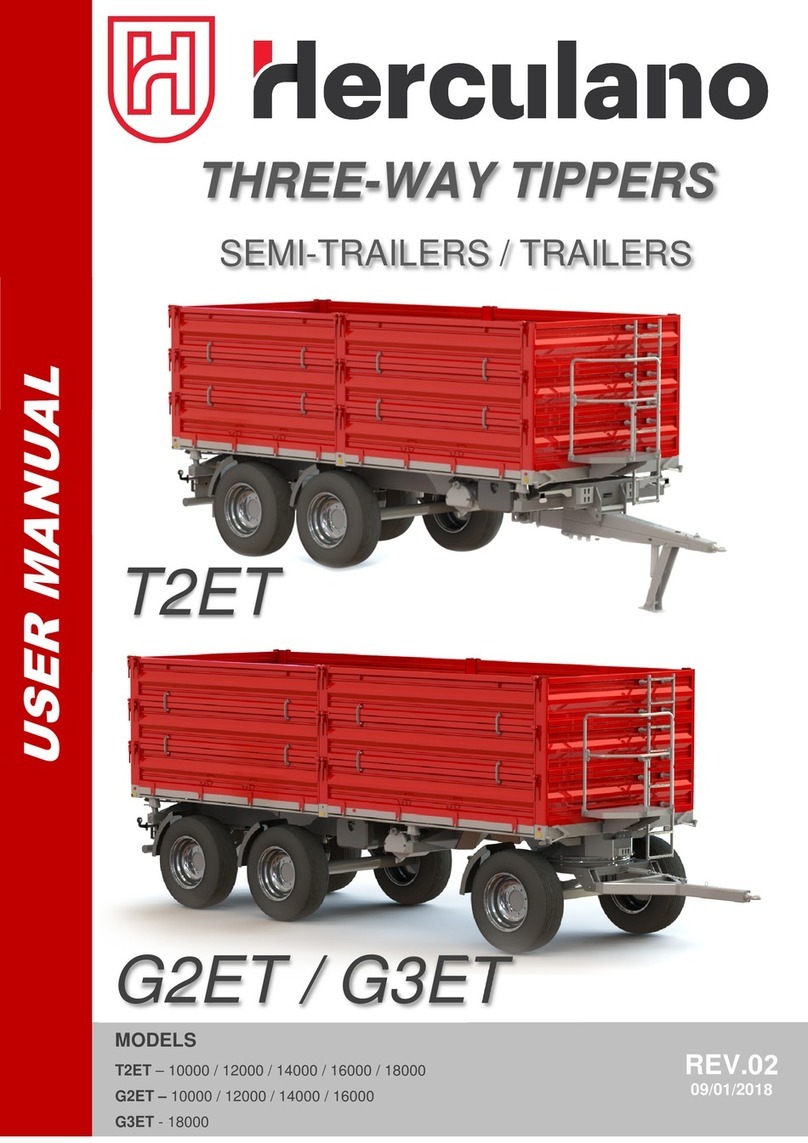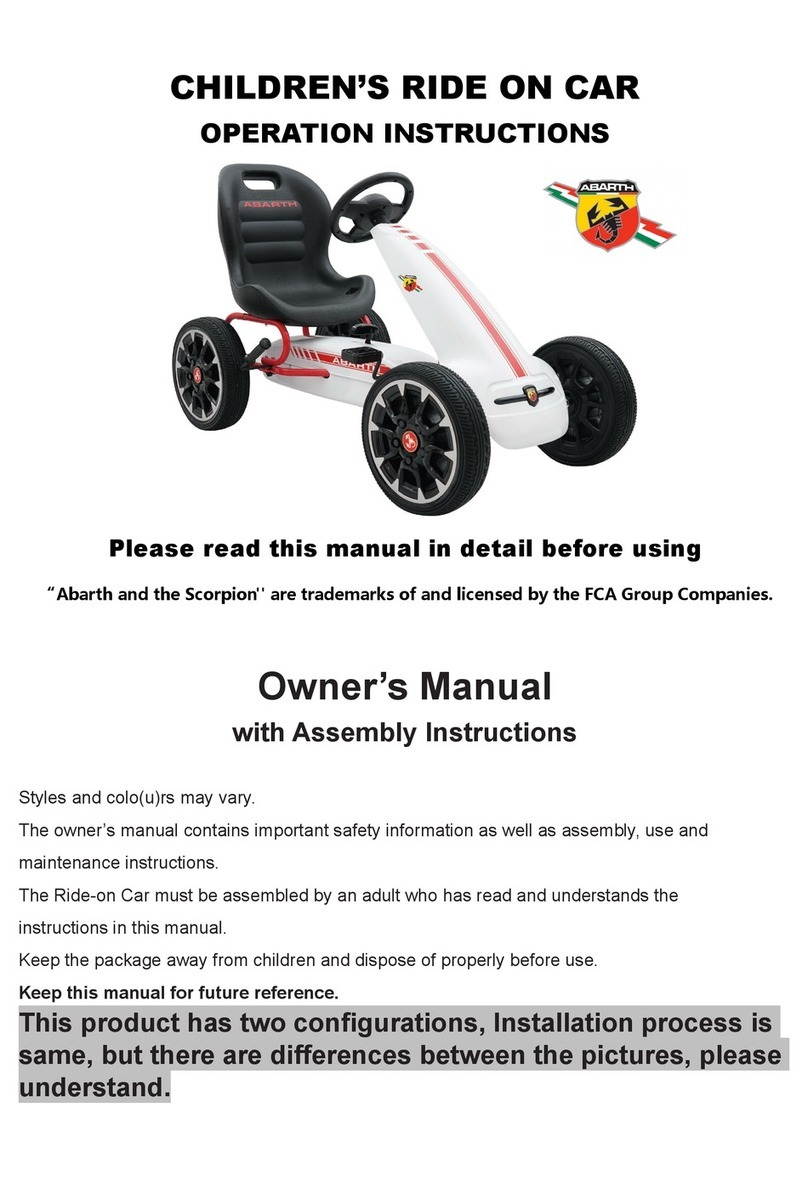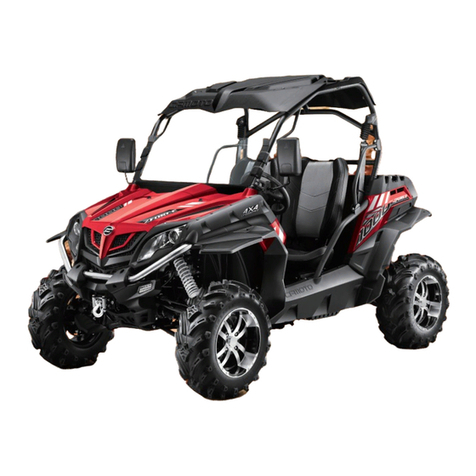Metal-Fach T739 User manual

ul. KRESOWA 62
T739 FARMING TRUCK TRAILER
OPERATION INSTRUCTIONS
EDITION I, JUNE 2014 EN

2OPERATING INSTRUCTIONS MANUAL - T739 FARMING TRUCK TRAILER
CE DECLARATION OF CONFORMITY
FOR THE MACHINE
METAL-FACH COMPANY
ul. Kresowa 62
16-100 SOKÓŁKA
acting as the manufacturer
Machine:
We declare that the machine which this declaration concerns meets the following requirements:
- Directive 2006/42/EC OF THE EUROPEAN PARLIAMENT AND OF THE COUNCIL dated
May 17th 2006 on machines and the Resolution of the Minister of Economy of October 21st
2008 concerning general requirements for machinery (Journal of Laws, issue 199 item 1228);
The following harmonised standards were used for compliance evaluation:
PN-EN 1853+A1:2009
PN-EN ISO 13857:2010
PN-EN ISO 4254-1: 2013
PN-EN ISO 12100:2012
- and the following standards: PN-ISO 3600:1998, PN-ISO 11684:1998; and the Declaration of
the Ministry of Transportation, Construction and Marine Economy dated 06/06/2013 on the
publication of the consolidated text of the Resolution of the Ministry of Infrastructure on the
technical requirements for vehicles and the scope of their necessary equipment (Journal of
Laws of 22/08/2013, item 951), as amended
Safety Test Report no.
Unit responsible for engineering documentation: Metal-Fach Engineering Department
This Declaration of Conformity becomes null and void if the machine design is changed
or modied in any manner without prior consent from the manufacturer.
Sokółka President of the Managment Board
Jacek Marek Kucharewicz
FARMING TRUCK TRAILER
type/model: T739-............................................
serial number: .....................................................
year of manufacture:..........................................

3
OPERATING INSTRUCTIONS MANUAL - T739 FARMING TRUCK TRAILER
Thank you for choosing our farming truck trailer, a machine designed for efficient and reliable operation. This Manual will let you fully use the
advantages of our trailer. The Manual contains a detailed table of contents followed by descriptions which will allow to easily identify the trailer
and to make the best use of it. The information regarding safety of operation, description of coupling with a tractor, technical service activities
and storage conditions are listed on the following pages of the Manual.
A spare parts catalogue containing the list of the trailer major components allowing for easy ordering is attached to the Manual in a digital
form on a CD. A printed version of the catalogue can be purchased at authorised service outlets or directly from the manufacturer.
Both the Manual and the Spare Parts Catalogue contain basic information on the product. The elements fitted to the equipment may be slightly
different from those presented in the Manual.
The manufacturer reserves the right to introduce changes without notice.
ALL OPERATORS OF THIS TRAILER MUST UNDERSTAND THE CONTENTS OF THE OPERATING
INSTRUCTIONS BEFORE COMMENCING WORK. THE MANUAL IS A PART OF THE T739 TRAILER
ESSENTIAL EQUIPMENT.
The latest Operating Manuals and Parts Catalogues are available on our website:
http://www.metalfach.com.pl/en/materialy-do-pobrania
IMPORTANT

4OPERATING INSTRUCTIONS MANUAL - T739 FARMING TRUCK TRAILER
INDEX
1. TRAILER IDENTIFICATION, GENERAL SAFETY RULES 5
1.1. Trailer identification 5
1.2. Trailer intended use 6
1.3. Trailer design 6
1.3.1. Trailer equipment 6
1.3.2. Chassis 6
1.3.3. Loading space 7
1.3.4. Load body hydraulic tipping mechanism 7
1.3.5. Electrical system (signalling and warning) 8
1.3.6. Braking system 8
1.4. Trailer characteristics 9
1.5. Warning symbols 10
1.6. General safety rules 12
1.6.1. Safety of operation 12
1.6.2. Tyres 13
1.6.3. Pneumatic system 14
1.6.4. Periodic maintenance 14
2. OPERATION WITH TRACTORS 15
2.1. Coupling the trailer with the tractor 15
2.2. Decoupling from the tractor 15
3. COMMISSIONING 16
4. ONGOING ADJUSTMENTS 16
4.1. Wheels – bearing clearance adjustment 16
4.2. Wheels – tyres 16
4.3. Brakes 17
4.3.1. Brakes – servicing the brake pneumatic system 17
4.3.2. Brakes – adjustment of the braking system components 17
5. TRAILER OPERATION 19
5.1. Loading the body 19
5.2. Unloading the body 19
5.3. Hydraulic system 21
5.3.1. Hydraulic system – servicing of the load body hydraulic tipping system 21
5.3.2. Hydraulic system – adjustment of the load body hydraulic tipping
mechanism
21
6. PERIODIC INSPECTION 22
6.1. Lubrication 22
6.2. Maintenance and servicing 22
6.3. Repair instructions 23
7. TROUBLESHOOTING 24
8. STORAGE, SALE AND SHIPPING TO USER 25
8.1. Storage 25
8.2. Sales 25
8.3. Shipping to user 25
9. AUTHORISED SERVICE 26
9.1. Warranty service 26
9.2. Ongoing maintenance 26
9.3. Ordering spare parts 26
10. DISMANTLING, DISPOSAL AND ENVIRONMENTAL PROTECTION 26
11. RESIDUAL RISKS 27
11.1. Description of residual risks 27
11.2. Evaluation of the residual risk 27
12. WARRANTY CONDITIONS 28

TRAILER IDENTIFICATION, GENERAL SAFETY RULES
5
OPERATING INSTRUCTIONS MANUAL - T739 FARMING TRUCK TRAILER
1. TRAILER IDENTIFICATION, GENERAL SAFETY RULES
1.1. TRAILER IDENTIFICATION
The identification data is found on the trailer nameplate located on
the left-hand side of the trailer chassis front crosspiece. The trailer
serial number is stamped on the nameplate and under the plate,
directly on the machine frame.
It is forbidden to drive the trailer on public roads or
operate the trailer without its nameplate or with an
illegible nameplate.
WARNING!
Data plate
Trailer consecutive number
DETAIL F
SCALE 1:25
Fig. 1. Nameplate location on the machine
If the machine is sold to another user, it must be supplied with the
Operating Manual. It is advised that the supplier has a confirmation
stating that the Manual was transferred together with the machine,
signed by the buyer and filed.
Carefully read the operating manual.
When purchasing the machine, check the serial
number indicated in the Manual and the warranty
sheet against the serial number stamped on the
nameplate.
IMPORTANT
THE MANUAL IS A PART OF THE TRAILER ESSENTIAL
EQUIPMENT.

6OPERATING INSTRUCTIONS MANUAL - T739 FARMING TRUCK TRAILER
TRAILER IDENTIFICATION, GENERAL SAFETY RULES
1.2. TRAILER INTENDED USE
The trailer is intended for transport of crops and other bulk or
loose materials within a farm and on public roads.
The trailer is unloaded manually or by tipping the load body to the
rear or to the sides. The trailer is designed for coupling with farming
tractors of varying power ratings, equipped with an external power
hydraulic system, a power outlet for the electrical lighting and warning
systems and the braking system of hitched machines, and a transport
hitch.
Do not use this trailer to carry fuel, gas cylinders and similar
loads due to the compliance requirements for transport of hazardous
materials.
• Do not use the trailer to transport: fuel, gas cylinders, or toxic
materials that may cause environmental pollution or any other
hazardous materials. The manufacturer shall not be liable for any
resulting damage as it is solely incurred by the owner.
• The trailer shall only be used by persons who have understood the
operating manual and who have been trained in hazards and first aid
for accident victims.
• Follow all applicable laws for accident prevention and any other
recognised rules of engineering safety, occupational medicine and
road traffic safety.
1.3. TRAILER DESIGN
The T739 is a metal structure with open load surface. The trailer
features a pneumatic or hydraulic service brake and a parking brake
that is manually operated via a screw gear, actuating the friction
components of the rear axle service brake.
The trailer features a complete signalling and warning system (an
electrical system and reflective lights).
The trailer is also suitable for transport on public roads.
The trailer is manufactured in accordance with:
• Directive 2006/42/EC
and the following standards:
• PN-EN ISO 4254-1: 2013
• PN-EN 1853+A1:2009
• PN-EN ISO 13857:2010
• PN-EN ISO 12100:2012
1.3.1. TRAILER EQUIPMENT
The essential equipment of each trailer includes:
• Operating Instructions Manual;
• Warranty card with warranty conditions;
• Bracket for the sign "Slow-moving vehicle";
• Two-line pneumatic brakes with adjustable braking force;
• Parking brake;
• Lighting installation;
• Semi-elliptic spring suspension;
• Tarpaulin cover with supports;
• safety stairs.
On customer's request (additional costs incurred), the
manufacturer may equip the trailer with the Slow-Moving Vehicle sign
and a reflective warning triangle.
1.3.2. CHASSIS
The trailer chassis is composed of the following subassemblies:
• chassis frame
• tow bar
• wheel sets
• suspension assemblies
The chassis frame and the tow bar are welded structures made of
steel sheet and profiles.

TRAILER IDENTIFICATION, GENERAL SAFETY RULES
7
OPERATING INSTRUCTIONS MANUAL - T739 FARMING TRUCK TRAILER
The trailer wheel sets are composed of:
• axles
• road wheels
• road wheel brakes
The axles are made of thick-wall pipes terminated with plugs on
which land wheel hubs are set by cone bearings. They are single wheels
equipped with drum brakes with the shoes actuated by mechanical
expander cams.
The trailer axle suspension consists of steel semi-elliptic leaf
springs attached to the turntable frame and the bottom frame by pins
and sliders. The wheel sets are attached to the springs by bolts.
1.3.3. LOADING SPACE
The trailer loading space comprises the following:
• The top frame (box frame) that is set on the bottom frame (chassis
frame) in articulated seats secured by pins which serve as pivots
during tilting (tipping) of the top frame (load body/box).
• The side walls/boards and their top sections are singular
components. Each component features a separate set of locks for
closing and opening of individual wall and top sections independently
of each other and in any order. These design solutions increase
functionality and facilitate operation of the trailer.
• The wall and top section locks are secured against accidental
release.
1.3.4. LOAD BODY HYDRAULIC TIPPING MECHANISM
The hydraulic mechanism is designed for automatic unloading
of the trailer by tipping the load body backwards or sideways. The
hydraulic tipping system is fed with oil from the tractor hydraulic
system.
The hydraulic system comprises:
• coupling valve plug;
• hydraulic lines;
• single action hydraulic actuator;
• cut-off valve;
• fitting and joining hardware.
Fig. 1 shows the diagram of the load body hydraulic tipping system.
The lifting and lowering of the load body is controlled by the DCV in the
tractor hydraulic system.
Fig. 1. Diagram of the load body hydraulic tipping system
1–hydraulic actuator; 2–hydraulic lines; 3–cut-off valve; 4–cut-
off valve control cable; 5 – coupling valve plug, 6 – control valve;
7–coupling valve socket.
The cut-off valve limits the load body tilt angle during
tipping to the sides. The valve is pre-adjusted by the
trailer manufacturer. Do not adjust it on your own.
ATTENTION!

8OPERATING INSTRUCTIONS MANUAL - T739 FARMING TRUCK TRAILER
TRAILER IDENTIFICATION, GENERAL SAFETY RULES
1.3.5. ELECTRICAL SYSTEM (SIGNALLING AND
WARNING)
The trailer electrical system is designed for 12 V DC supply from
the driving tractor system.
The diagram of the electrical system and the trailer lights layout are
shown in Fig. 2.
Fig. 2. Trailer's electrical system diagram
1–7-pin plug; 2–7-pin socket; 3–right tail cluster lamp; 4–left tail
cluster lamp; 5–turn indicator light bulbs; 6–tail parking light bulbs;
7–stop light bulbs; 8–registration plate light bulbs; 9–front parking
light bulb; 10–outline marker lamp.
1.3.6. BRAKING SYSTEM
The T739 trailer is equipped with the following braking systems:
• service brake: pneumatically actuated two-line system controlled
from the driver's seat by pressing the tractor's brake pedal;
• parking brake: mechanically controlled by hand via a crank lever
mechanism and a screw gear, located on the left side of the trailer
and operating the rear tandem axle wheels.
The service brake design ensures automatic braking of trailer land
wheels if the pneumatic system is accidentally decoupled between the
trailer and the tractor.
The two-line pneumatic system diagram is shown in the figure
below.
Fig. 3. Two-line pneumatic system diagram
1 – 1st trailer pneumatic connector; 2– air filter; 3 – control valve;
4–air tank; 5–water drain valve; 6–manual braking force control;
7–check connector; 8–pneumatic diaphragm cylinder, 9–2nd trailer
pneumatic connector.

TRAILER IDENTIFICATION, GENERAL SAFETY RULES
9
OPERATING INSTRUCTIONS MANUAL - T739 FARMING TRUCK TRAILER
1.4. TRAILER CHARACTERISTICS
Item
no.
Content
I General data
1. Vehicle type farming trailer
2. Manufacturer METAL-FACH COMPANY
16-100 Sokółka, ul. Kresowa 62
3. Type (model) T739
4. Body type platform
5. Nameplate location chassis frame front crosspiece
6. S/N stamping location on the nameplate and underneath
II Dimensions and weight
7. Length, mm 7500
8. Width, mm 2550
9. Height
(w/top section), mm
3000
10. Number of axles, pcs. 2
11. Wheel base, mm 3840
12. Wheel track, mm 1900
13. Loading space dimensions
- length, mm 5385
- width, mm 2410
- height (w/top section),
mm
600
(1400)
14. Loading surface height,
mm
1373
15. Tow bar oscillation
height, mm
-
16. Tow bar hitch-ring
diameter, mm
40
17. Vehicle ramp
clearance, mm
490
18. Vehicle kerb weight, kg 4020-4580
19. Permissible vehicle
overall weight, kg
18000
- per axle, kg 9000
20. Maximum axle load, kN
- per axle, kN 88.29
21. Permissible load
capacity, kg
13420-13880
III Suspension
22. Suspension type dependent, with springs
23. Spring component type
and style
longitudinal 2-leaf parabolic springs
IV Wheels and tyres
24. Number of wheels, pcs. 4
25. Wheel disk size 11.75x22.5
26. Tyre size and PR
number
385/65 R22.5
Manufacturer Bandemarkt SAWA/KORMORAN/
DĘBICA/MICHELIN
Tyre pressure [bar] 5 to 9, depending on the manufacturer
V Braking system
27. Service brake
- type mechanical, drum-type

10 OPERATING INSTRUCTIONS MANUAL - T739 FARMING TRUCK TRAILER
TRAILER IDENTIFICATION, GENERAL SAFETY RULES
- control pneumatic, positive pressure, two-
line brake system;
- no. of wheels
operated
4 wheels
28. Parking brake
- type mechanical, drum-type
- control manual, by a screw gear
- operated components 2 rear axle wheels
VI Electrical system
29. Voltage rating, V 12 V, feed by the driving tractor
VII Operating data
30. Maximum speed, km/h 40
31. Maximum transport
speed, km/h
30
VIII Additional Information
32. Driving tractor 100 kW minimum
33. Hydraulic oil
cleanliness
not less than 9 acc. to WAS 1638
(category 20/18/15 acc. to ISO 4406-
1996)
1.5. WARNING SYMBOLS
Item
no.
Safety symbol
(sign)
Meaning of the symbol
(sign) or text
Location on the
machine
1.
Read the Operating
Instructions.
On the load body
frame front
crosspiece.
2.
Turn off the engine and
remove the ignition key before
servicing or repairs.
On the load body front
crosspiece.
3.
Keep a safe distance from
power lines.
On the load body front
crosspiece.
4.
Do not reach into the crushing
area if the machine may move. On side walls/panels.

TRAILER IDENTIFICATION, GENERAL SAFETY RULES
11
OPERATING INSTRUCTIONS MANUAL - T739 FARMING TRUCK TRAILER
5.
Install the support before
entering the hazardous area.
On the chassis side
frame member, at the
support.
6.
Do not ride on the machine –
use the passenger seat only.
On the load body front
wall
7.
Keep a safe distance from the
machine.
On the load body front
wall
8.
Do not stand on ladders and
platforms while the tractor is
moving.
At the ladder.
9.
Feet (toes) crushing hazard.
Force applied from above. On the tow bar.
10.
Lifting point. On the chassis frame
side members.
11. Caution!
Do not perform any checks or
servicing under the loaded or
tilted load body without the
support.
At the support.
12. Caution!
Do not remain within the range
of discharged loads.
Do not enter the trailer when it
is hauled.
On the load body front
wall.
13. Overall weight: 18000 kg. On the load body left
and right wall.
14. Maximum hydraulic system
pressure: 16 MPa.
On the floor frame
front crosspiece.
15. Maximum pneumatic system
pressure:
• 0.6 MPa, single-line system
• 0.8 MPa, two-line system
On the load body front
wall.
16. "550 kPa" -
385/65R22.5 tyres
(BANDENMARKT)
Over the wheels.

12 OPERATING INSTRUCTIONS MANUAL - T739 FARMING TRUCK TRAILER
TRAILER IDENTIFICATION, GENERAL SAFETY RULES
The trailer user is required to keep the warning
symbols and text on the trailer legible during its
entire operating life. If damaged or destroyed, replace
with new ones.
ATTENTION!
1.6. GENERAL SAFETY RULES
Before each start of work, inspect the trailer for work safety.
1. Aside from the guidelines in these Operating Instructions, follow
the general regulations for safety and accident prevention.
2. The affixed information and warning signs and text indicate
important guidance for safe operation. Follow it for your safety.
3. Start the trailer only when all required equipment is connected and
secured from unintended release or opening (e.g. the hitch and tow
bar system, couplings, etc.).
4. Understand all equipment and controls, as well as their functions,
before work. It is too late to learn that during work.
5. The trailer must not be used by persons who are under the influence
of alcohol and/or other substances, and/or not trained or suitably
licensed to operate motor vehicles.
1.6.1. SAFETY OF OPERATION
1. All work safety information shall be given to all other users of the
trailer.
2. Check the direct environment (for children and bystanders) before
start. Pay particular attention when visibility is poor.
3. Do not remain on the trailer in motion, when coupling the trailer
with a tractor and when loading or unloading the trailer.
4. After unloading the trailer, lower the load body completely. Never
leave the trailer unattended with its load body raised.
5. Enter the trailer only when it has completely stopped and with the
tractor engine stopped.
6. Lift and lower the load body only from the driver's seat.
7. Hitch the trailer according to regulations, couple only with
recommended equipment and secure the tow bar hitch-ring to the
tractor transport hitch.
8. Exercise extreme caution when coupling/decoupling the trailer
with/from the tractor.
9. When installing and removing supports, security/safety equipment
and ladders, these types of equipment must always be positioned
to ensure safety to operators.
10. Follow the maximum permissible axle loads, total weight and
transport dimensions.
11. Do the following checks: coupling and functional test of brakes
and lights, inspect the slow-moving vehicle sign, and check other
protective devices.
12. Do a functional test of lights and brakes before driving. Also
prepare the trailer as recommended in Section "Travelling on
public roads".
13. Mind the changes in vehicle behaviour, steerability and braking
efficiency due to the hitched trailer and its load.
14. When towing the trailer, mind the layout of loads and/or inertia,
especially when the load is unevenly distributed.
15. Do not remain within the range of discharged load.
16. Start the hydraulic lift (tipping) of the load body only when:
- the trailer is coupled with the tractor, AND
- the trailer is parked on a hard and level ground, AND
- no persons remain in the unloading area, AND
- the tractor's axis is aligned with the trailer, AND
- the machines are at a safe distance from all power lines,
AND
- there are no strong gusts of wind.

TRAILER IDENTIFICATION, GENERAL SAFETY RULES
13
OPERATING INSTRUCTIONS MANUAL - T739 FARMING TRUCK TRAILER
17. If it is necessary to unload to the rear while parking on a slope,
the trailer with the tractor must be parked in the uphill direction.
If unloading to the side on a slope, tilt the load body to the side
opposite to the trailer's direction of gradient.
18. During all work with the raised load body, secure it against falling
with the support that has been delivered with the trailer. Turn off
the tractor engine and remove the ignition key.
19. Be careful to avoid crushing of fingers and hands during opening
and closing of the load body walls.
20. Mind the warnings of crush and cut hazard areas when starting the
work with trailer. There is a risk of injury when coupling/decoupling
the trailer with/from the tractor. When coupling/decoupling, do not
enter between the trailer and the tractor or stand behind the trailer
if the trailer is not secured with wheel chocks or the parking brake.
21. No person is allowed to remain between the trailer and the tractor
if the vehicle is not secured against rolling with parking brake and/
or wheel chocks.
22. When parked, secure the tractor and the trailer against rolling.
23. Do not drive with the lifted load body.
24. When raising the load body, maintain a safe distance from power
lines. The C.2.30. sign acc. to PN-ISO 11684:1998 on the front wall
of the trailer warns of power lines.
25. During all servicing or repair works which require lifting the load
body, the body must be empty and secured with the mechanical
support against accidental falling.
26. Always adapt your driving speed to the conditions. Avoid rapid
turns when driving uphill or downhill.
27. Maintain a safe distance from the U-turn range of the tractor and
trailer train.
28. Ensure adequate visibility (with the help of a signalling person, if
necessary) when driving in reverse.
29. Mind the inertia of the trailer when cornering.
30. Additional protection for the load transported on the trailer (chains,
tarpaulin, plastic sheet, nets, transport straps, etc.) may be applied
only with tractor engine off and the ignition key removed.
31. Remove functional disturbances of attachments only with the
engine turned off and the ignition key removed.Remove functional
disturbances of attachments only with the engine turned off and
the ignition key removed.
32. Enter the load body surface only after turning off the drive and
stopping the tractor engine. Remove the ignition key.
33. Always turn off the engine and remove the ignition key before
exiting the tractor. Engage the parking brake and secure the trailer
with the wheel chock.
34. When travelling on public roads, the permissible axle load of the
trailer must not exceed 88.29 kN (front) and 88.29 kN (rear).
35. The maximum permissible pressure of the hydraulic system is 16
MPa.
36. The maximum permissible pneumatic pressure of the two-line
system is 0.8 MPa.
37. Prepare the trailer for work (connect the pneumatic and hydraulic
hoses, etc.) with the tractor engine off and the ignition key removed.
38. The manufacturer delivers the trailer completely assembled.
39. All hydraulic lines must be replaced every 6 years.
40. Noise – the equivalent sound pressure emission corrected by A
characteristics (LpA) does not exceed 70 dB.
1.6.2. TYRES
1. Make sure to secure the trailer against accidental movement when
servicing the tyres.
2. The wheels and tyres shall be repaired by trained personnel with
adequate tools.
3. Regularly check the tyre pressure. Maintain the recommended
pressure values.

14 OPERATING INSTRUCTIONS MANUAL - T739 FARMING TRUCK TRAILER
TRAILER IDENTIFICATION, GENERAL SAFETY RULES
4. Protect the tyres from sunlight during prolonged parking of the
trailer.
5. Replace the wheels with the trailer empty, if possible.
1.6.3. PNEUMATIC SYSTEM
1. The pneumatic system is under high pressure.
2. When connecting the pneumatic lines with the pneumatic system of
the tractor, ensure that the valves on the tractor and the trailer are
depressurised.
3. Periodically inspect the pneumatic connections. Replace all
damaged and aged parts immediately. Replace the lines as
recommended in the manufacturer's technical requirements.
Replace hoses every five years unless damage is found earlier.
4. Before attempting any work on the pneumatic system, depressurise
it and turn off the tractor engine.
5. All repair work on the pneumatic system may only be performed by
specialist services of the trailer's manufacturer.
1.6.4. PERIODIC MAINTENANCE
1. All maintenance, repair and cleaning operations, as well as
troubleshooting must be performed after turning the drive and the
tractor engine off. Remove the ignition key.
2. Inspect all bolts and nuts periodically and retighten if necessary.
Replace regular bolts only with the bolts of the same quality and
strength ratings.
3. When servicing under the lifted and tipped AND unloaded load
body, always secure the body with the support supplied with the
trailer.
4. Use correct tools and safety gloves when replacing any parts.
5. After completing your work, thoroughly clean the trailer to leave no
remains of the load on the body.
6. Before arc welding and/or working on the electrical system, isolate
the continuous electrical power supply.
7. The safety/protection equipment wears out, which requires periodic
adjustments, inspection and replacement when necessary.
8. Use only the original spare parts recommended by METAL-FACH
Sp. z o.o. Sokółka.
9. Store the trailer in sheltered areas (preferably on level and
hardened ground) and in a manner which prevents injuries of
people and animals.
10. Release all worn out parts to authorised recycling points while
following all applicable environmental protection requirements.

15
OPERATING INSTRUCTIONS MANUAL - T739 FARMING TRUCK TRAILER
TRAILER IDENTIFICATION, GENERAL SAFETY RULES / OPERATION WITH TRACTORS
2. OPERATION WITH TRACTORS
2.1. COUPLING THE TRAILER WITH THE TRACTOR
The T739 trailer can only be operated with tractors in a good
working order and the minimum power output of 100 kW which have two
sockets for the external hydraulic system and a hitch (top transport).
Do the following to couple the T739 trailer with the tractor:
• approach the trailer with the tractor so that the tow bar hitch-ring is
placed between the tractor hitch;
• turn off the tractor's engine, remove the ignition key and engage the
parking brake;
• couple the tow bar hitch-ring with the hitch by inserting the bolt and
secure the joint with the safety pin;
• connect the electrical, hydraulic and pneumatic lines with the tractor
external sockets;
• connect the brake line of the trailer to the brake system socket on the
tractor.
2.2. DECOUPLING FROM THE TRACTOR
Do the following actions to decouple the trailer from the tractor:
• stop the tractor with the trailer at the location where the latter will be
left, and engage the tractor's parking brake;
• engage the trailer's parking brake;
• if the trailer stands on an uneven or sloping ground, secure it against
rolling down by chocking the wheels;
• disconnect the electrical, hydraulic and pneumatic lines from the
tractor;
• remove the safety from the hitch pin and then remove the pin – this
will decouple the tow bar from the hitch. Drive away with the tractor
and reinstall the pin in the hitch.
Do not decouple the trailer from the tractor when:
• The load body is lifted;
• The trailer is not secured against rolling away.
ATTENTION!

16 OPERATING INSTRUCTIONS MANUAL - T739 FARMING TRUCK TRAILER
COMMISSIONING / ONGOING ADJUSTMENTS
3. COMMISSIONING
Do the following before commissioning the trailer:
• understand the names and locations of individual assemblies/
components of the trailer;
• check the tyre pressure;
• couple the trailer with the tractor;
• set the tow bar hitch-ring of the trailer at the trailer transport hitch
height;
• couple the hitch-ring with the trailer hitch;
• secure the hitch pin against falling out;
• turn off the tractor's engine;
• engage the tractor's parking brake;
• connect the appropriate sockets and plugs of the pneumatic and
electrical systems;
• perform functional checks of the electrical, pneumatic and hydraulic
systems of the tractor and of the trailer, and check leak tightness of
the hydraulic and pneumatic systems on both vehicles;
• check all equipment, the connections and safety from accidental
release or misalignment;
• release the trailer parking brake;
• perform all these actions each time before working with the trailer.
Use only tractors that are fit for service (with
the transport hitch, the hydraulic and pneumatic
systems, and the signalling/warning system
working).
ATTENTION!
4. ONGOING ADJUSTMENTS
In order to maintain proper performance, the T739 trailer requires
the following adjustments:
• Adjustment of the wheel bearing clearance;
• Tyre servicing;
• Hydraulic system servicing;
• Adjustment of the braking system components.
4.1. WHEELS – BEARING CLEARANCE ADJUSTMENT
During the first operating hours of a newly purchased trailer (i.e.
after approximately 100 km of mileage) and further operation (i.e. after
the next 1500 or 2000 km), check the wheel bearing clearance and
adjust, if necessary.
To do so:
1. Couple the trailer with the tractor and engage the tractor parking
brake.
2. Jack up one side of the trailer to lift the wheel from the ground on
this side and secure the trailer against falling.
3. If the wheel has excessive clearance, remove the hub cap and
remove the crown nut clevis pin.
4. Rotate the wheel and tighten the crown nut at the same time until
the wheel stops turning.
5. Loosen the crown nut by 1/6 to 1/3 of the full turn, i.e. until the
nearest clevis pin groove is aligned with the hub pivot hole.
6. Secure the nut with a new clevis pin, and reinstall and retighten the
hub cap.
4.2. WHEELS – TYRES
Servicing of the tyres involves checking their condition visually and
checking the tyre pressure. It is also essential to check that the tyres
have no cracks that expose or damage the carcass, and that the hubs,
wheel disks and their fastening are in good condition.

ONGOING ADJUSTMENTS
17
OPERATING INSTRUCTIONS MANUAL - T739 FARMING TRUCK TRAILER
Periodically inspect the wheel nuts (i.e. the condition
and tightness before each use of the trailer);
retighten if necessary.
ATTENTION!
Periodically inspect the wheel nuts (i.e. the condition
and tightness before each use of the trailer);
retighten if necessary.
Nut tightening torques for different thread sizes:
M18x1.5 = 270 Nm.
M20x1.5 = 350 Nm.
M22x1.5 = 475 Nm.
ATTENTION!
After the first travels with loads and after each 100
km, inspect the tightness of wheel nuts and retighten
if necessary.
Check the tyre pressure. The tyre pressure rating on
the symbol at the trailer wheels applies to transport
at the maximum permissible speed (at the maximum
payload).
IMPORTANT
4.3. BRAKES
4.3.1. BRAKES – SERVICING THE BRAKE PNEUMATIC
SYSTEM
When servicing the trailer, check the tightness and the condition of
parts and connections of the braking system, and periodically drain the
water condensate from the air tank.
Check the leak tightness of the system at the rated pressure of
approx. 800 kPa for the two-line system.
Leaks are detected by a distinct hiss or air bubbles (after coating
with soapy water) at the points of air escape from the system. If the
leaks are caused by damaged seals, lines or other parts (valves,
actuators, etc.), replace them.
Drain the water from the air tank by tilting the drain valve stem
to the side when the tank is pressurised; the drain valve must also be
unscrewed from the tank and cleaned of accumulated dirt once a year,
before the winter season.
4.3.2. BRAKES – ADJUSTMENT OF THE BRAKING
SYSTEM COMPONENTS
When servicing the trailer, check the condition of parts and
connections of the braking system, and periodically inspect the
lubrication of control elements.
Adjust the brakes when the following occurs:
• there is an excessive clearance between the shoes and the drum from
the brake shoe wear, resulting in decreased braking performance;
• the wheel brakes work unevenly and out of sync.
With the properly adjusted brakes, the braking force (i.e. the total
of braking forces at the circumference of the wheels) shall be at least
27% of the permissible total weight of the trailer when decelerating
with the service brake; the braking force (i.e. the total of braking forces
at the circumference of the wheels) when actuating the parking brake
shall be at least 16% of the permissible total weight of the trailer. Both
wheels on the same axle should be stopped evenly; the brake force
differential between the left and right trailer side shall not exceed 30%,
with 100% being the higher force.
Park the trailer so that the rear wheels rotate freely. Loosen the
nut (4) so that the arm (2) is able to move against the shaft (1). Retighten
the nut (4) when the position of the shaft (1) against the arm (2) results

18 OPERATING INSTRUCTIONS MANUAL - T739 FARMING TRUCK TRAILER
ONGOING ADJUSTMENTS
in a slight rubbing of the brake shoes against the drum while turning
the wheel. Repeat for the other wheel.
After the correct adjustment of friction components, the wheel
should rotate smoothly, without cogging or evident resistance (other
than caused by rubbing of the brake shoes against the drum). Slight
rub of the shoes against the drum, especially on a brand new trailer or
following replacement of the shoes is normal.
After completing the adjustment, check and adjust the parking
brake. The parking brake is adjusted by setting the cable length that
couples the expander shaft lever with the engaging mechanism. The
required sum of braking forces should be produced at the maximum
force applied to the hand crank of 40 daN (at the right angle between
the cable and the expander shaft lever).
Before driving, periodically inspect all braking
components for proper operation, tightness and
clearance. Adjust or repair as necessary.
ATTENTION!
Inspect the brake shoes at least each year. Replace
worn shoes. In order to achieve the required
braking performance after replacement of friction
components, remember to run them in (by driving
with frequent braking), which should be followed by
readjustment.
IMPORTANT
Fig. 5. Braking system components
1 – brake shoe expander shaft; 2 – expander shaft lever (arm);
3–arm adjusting comb on the expander shaft; 4–the link (follower)
that couples the pneumatic actuator rod with the expander shaft lever.

TRAILER OPERATION
19
OPERATING INSTRUCTIONS MANUAL - T739 FARMING TRUCK TRAILER
5. TRAILER OPERATION
5.1. LOADING THE BODY
Load the body only when the trailer is coupled with the tractor,
parked on level ground and with the tow bar in the forward driving
direction.
Use mechanical loading equipment (cranes, loaders, conveyors,
etc.) to load the trailer.
Make sure that all wall and top section locks are engaged before
loading the trailer.
Spread the load evenly across the entire load body surface. When
transporting materials that exert focused (topical) pressure on the
load body (e.g. large rocks), line the floor with thick planks first. This
will reduce the surface load on the floor and protect it against damage.
When transporting large volume materials, install the top sections
of the load body walls. If the transported materials protrude from
the trailer, follow the applicable traffic code regulations for proper
marking of protruding loads.
Do not exceed the permissible payload and
permissible axle loads, otherwise the trailer can be
damaged and the traffic safety compromised. The
transported load must be secured against shifting,
generating excessive noise and falling down on the
road.
ATTENTION!
Approximate weight values of certain goods, 1 m3 = kg
Soil 1600 – 1800 Legumes 760 – 820
Wheat 710 - 820 Construction rubble/
aggregate
1400 – 1850
Potatoes 625 – 725 Lime 900 – 1500
Sugar beets 650 – 700 Hard coal 1200 - 1600
5.2. UNLOADING THE BODY
The load body can be unloaded manually, with mechanical
equipment or by tipping the box with the hydraulic mechanism.
Unload by tipping the load body by following these actions in the
order presented below:
• Align the tractor with the trailer's axis;
• Engage the tractor's parking brake;
• Remove the safety pin that couples the load body with the chassis
frame (fig. 6):
a) unloading to the back – the pins (Fig. 6) must remain in the rear
bells of the load body;
b) unloading to the left – the pins must be installed in the left hand
bells;
c) unloading to the right side – the pins must be installed in the right
hand bells;
• Make sure that the pins on the side to which the trailer is to be
unloaded have been properly installed;
• Open the body wall locks on the unloading side;
• Tip the load body by operating the hydraulic actuator;
• After the load has been discharged, lower the body and secure the
wall(s) with the locks.

20 OPERATING INSTRUCTIONS MANUAL - T739 FARMING TRUCK TRAILER
TRAILER OPERATION
• If it is necessary to unload the trailer on a slope,
it is allowed to tip the trailer body upwards (with
the tractor and the trailer parked in the uphill
direction).
• No person is allowed to remain near the tipped
trailer body and within the range of discharged
load.
• Do not decouple the trailer from the tractor when
the load body is lifted.
• Before unloading by tipping the trailer load body,
you must always verify that the pins have been
removed on the correct side of the trailer. Failure
to remove the pins may destroy the trailer!
• Do not transport any persons on the trailer.
ATTENTION!
Open the top lock of the load body by moving the handle up and
depressing the button under the handle at the same time. Open the
bottom locks of wall segments by operating the central lock handle:
Fig. 6. Load body wall locks
1–lever safety stop pin; 2–central bottom lock handle; 3–lock adjustment mechanism;
4–central lock shaft.
Table of contents
Other Metal-Fach Utility Vehicle manuals

